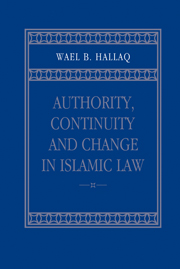Book contents
- Frontmatter
- Contents
- Preface
- 1 Juristic typologies: a framework for enquiry
- 2 Early ijtihād and the later construction of authority
- 3 The rise and augmentation of school authority
- 4 Taqlīd: authority, hermeneutics, and function
- 5 Operative terminology and the dynamics of legal doctrine
- 6 The jurisconsult, the author–jurist, and legal change
- Summary and conclusions
- Bibliography
- Index
5 - Operative terminology and the dynamics of legal doctrine
Published online by Cambridge University Press: 27 July 2009
- Frontmatter
- Contents
- Preface
- 1 Juristic typologies: a framework for enquiry
- 2 Early ijtihād and the later construction of authority
- 3 The rise and augmentation of school authority
- 4 Taqlīd: authority, hermeneutics, and function
- 5 Operative terminology and the dynamics of legal doctrine
- 6 The jurisconsult, the author–jurist, and legal change
- Summary and conclusions
- Bibliography
- Index
Summary
We earlier concluded that the rise of taqlīd as a modus operandi was symptomatic of the madhhab's final coming to maturity as an authoritative entity. It was the external expression of the internal juridical dynamics that came to dominate and characterize the madhhab both as an established and authorized body of doctrine and as a delimited hermeneutical enterprise. One of the functions of taqlīd, we have also seen, was the defense of the school as a methodological and interpretive entity, an entity that was constituted of identifiable theoretical and substantive principles. But the school was also defined by its substantive boundaries, namely, by a certain body of positive doctrine that clearly identified the outer limits of the school, limits beyond which the jurist ventured only at the risk of being considered to have abandoned his madhhab. An essential part of the school's authority, therefore, was its consistency in identifying such a body of doctrine. On the macro-level, this doctrine was formed of the totality of the founder's opinions, substantive principles, and legal methodology, whether they were genuinely his or merely attributed to him. Added to this were the doctrines of jurists deemed to have formulated legal norms in accordance with the founder's substantive and theoretical principles.
- Type
- Chapter
- Information
- Authority, Continuity and Change in Islamic Law , pp. 121 - 165Publisher: Cambridge University PressPrint publication year: 2001
- 1
- Cited by



